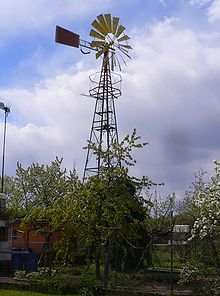Western wind turbine
A western wind turbine , Texas wheel , also called western windmill ( English westernmill ) or American (s) wind turbine / -mühle , is a multi-blade wind turbine mounted on a lattice mast with a flag for tracking the wind direction . This in the second half of the 19th century in North America developed wind turbine type has been and is predominantly as pumping station drive ( wind pump , English wind pump ) for loading and dehydration , and later also to the power generation used. Another application is the aeration of fish ponds using a diaphragm or air spring pump at the top of the windmill mast.
functionality
The wind turbine was developed by Daniel Halladay in 1854, has a rotor with mostly around 30 (up to approx. 150) rotor blades, develops up to 1 kW of power and is technically a slow runner due to the low speed . It achieves an efficiency of up to 30%. These machines are completely made of steel share and steel sheet produced. With its tail vane, the wind turbine turns automatically into the wind ; in the event of a storm (from wind force 7) it switches itself off by folding the individual segments of the split rotor backwards when the wind pressure is too high (compare: wind plate ). Later, simpler designs were developed with a spring-loaded, i.e. flexible stern wind vane; an additional, rigid side wind vane then develops a stronger torque that turns the wind turbine out of the wind. Alternatively, the axis of the wind turbine and the directional pivot pin on the mast are slightly offset from one another, so that the pressure on the wind turbine itself generates a moment that turns from the wind. Because of the series production, the complete metal production and the fully automatic operation, Western wind turbines were the first machines to meet modern wind power plant requirements.
The rotary movement generated by the wind is converted into a lifting movement by a crankshaft . This lifting movement is then used to pump water by a reciprocating piston pump .
distribution
After the development in North America, the simple and robust design spread quickly and was widely used on farms in North and South America , Australia and parts of Africa . Especially for locations without a connection to the public power supply, the wind turbines were important for self-sufficient water management and electricity production in island operation . For example, before the nationwide electricity supply was expanded by the overland control center in the 1920s, hundreds of so-called “Texas bikes” were set up to supply the businesses with electricity, especially on larger farms in the marshes on the west coast of Schleswig-Holstein.
After the end of the Second World War, Bavaria received around 3,000 such wind turbines from the Americans as part of the Marshall program, some of them produced in Germany. They were approx. 14 m high, always had 18 blades and each drove a piston water pump which was sunk into the earth in a 3 m deep shaft. They could be seen in the Allgäu until around 1958.
One still stands, preserved, in Dietmannsried in the Allgäu. In 2001, these could still be seen in Tunisia, but no longer in operation. A few western wind turbines could still be seen in the plains of Upper Austria in the 1970s. The last one, presumably installed by a former well builder from Lambach around the Second World War, was repaired in Unterroithen 5 without a pump and was even included in the 1980 emblem of Edt bei Lambach as a symbol of the place .
Between 1900 and 1965, 33 wind pumping stations were in operation on the island of Rügen. The only preserved one is with Lobbe . It has been out of service since 1955 and was reconstructed both 1987–1988 and 1996–1997.
Drawing of a Halladay turbine on the top of a wooden mast, 8 sets of 10 blades each fold in strong winds from the rotor plane, from 1854, designed by Daniel Halladay (* 1826 Vermont)
Halladay turbine with short blades in droves, in Ruprechtov , Czech Republic, listed (2011)
Poldaw pump in Wicken Fen ( Cambridgeshire , UK, 2014) 18-bladed by Neale Consulting Engineers Limited , GB Windpumps
Wind turbine from Aermotor Windmill Company (Chicago) on the Trinity-Basecamp , the test and measurement site of the world's first nuclear explosion, USA (approx. 1945) 18-bladed, inscription "The Aermotor Co., Chicago"
See also
Web links
- Akshay Dafade: Wind pump Mechanism - youtube.com, video (6:28), January 7, 2015. - Structure and function, explained schematically.
- DoRite Fabrication, Jim Bollinger: Vintage Aermotor Windmill Restoration Ep 6: Wheel and Sails Rebuild, Refurbishing the Tail Vane Logo youtube.com, Video (11:34), January 28, 2016. - Restoration of an Aermotor windmill from the 1940s. (Part 6 of 7 (?))
- RockRidgeWindmills's channel: Taking Down a Large Aermotor Windmill - youtube.com, Video (2:48), Cloverdale , California, USA. - Dismantling of a 20 foot (6.1 m) diameter wind turbine using a truck-mounted crane.
Individual evidence
- ↑ Before You Buy a Windmill Aerator! youtube.com, video (9:05), Mescan Windmills, Columbia Statio, Ohio, USA. November 19, 2007, accessed March 14, 2017.
- ↑ R. Seiferth: Investigation of four wind turbines . 1925
- ↑ http://www.geschichte-sh.de/electrification/




